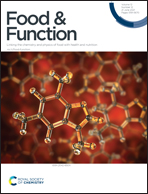Live and ultrasound-inactivated Lacticaseibacillus casei modulate the intestinal microbiota and improve biochemical and cardiovascular parameters in male rats fed a high-fat diet†
Abstract
This study aimed to evaluate the effects of ingestion of live (9 log CFU mL−1) and ultrasound-inactivated (paraprobiotic, 20 kHz, 40 min) Lacticaseibacillus casei 01 cells for 28 days on healthy parameters (biochemical and cardiovascular) and intestinal microbiota (amplicon sequencing of 16S ribosomal RNA) of rats fed a high-fat diet. Twenty-four male Wistar rats were divided into four groups of six animals: CTL (standard diet), HFD (high-fat diet), HFD-LC (high-fat diet and live L. casei), and HFD-ILC (high-fat diet and inactivated L. casei). The administration of live and ultrasound-inactivated L. casei prevented the increase (p < 0.05) in cholesterol levels (total and LDL) and controlled the insulin resistance in rats fed a high-fat diet. Furthermore, it promoted a modulation of the intestinal microbial composition by increasing (p < 0.05) beneficial bacteria (Lachnospiraceae and Ruminoccocaceae) and decreasing (p < 0.05) harmful bacteria (Clostridiaceae, Enterobacteriaceae, and Helicobacteriacea), attenuating the effects promoted by the HFD ingestion. Only live cells could increase (p < 0.05) the HDL-cholesterol, while only inactivated cells caused attenuation (p < 0.05) of the blood pressure. Results show beneficial effects of live and inactivated L. casei 01 and indicate that ultrasound inactivation produces a paraprobiotic with similar or improved health properties compared to live cells.



 Please wait while we load your content...
Please wait while we load your content...